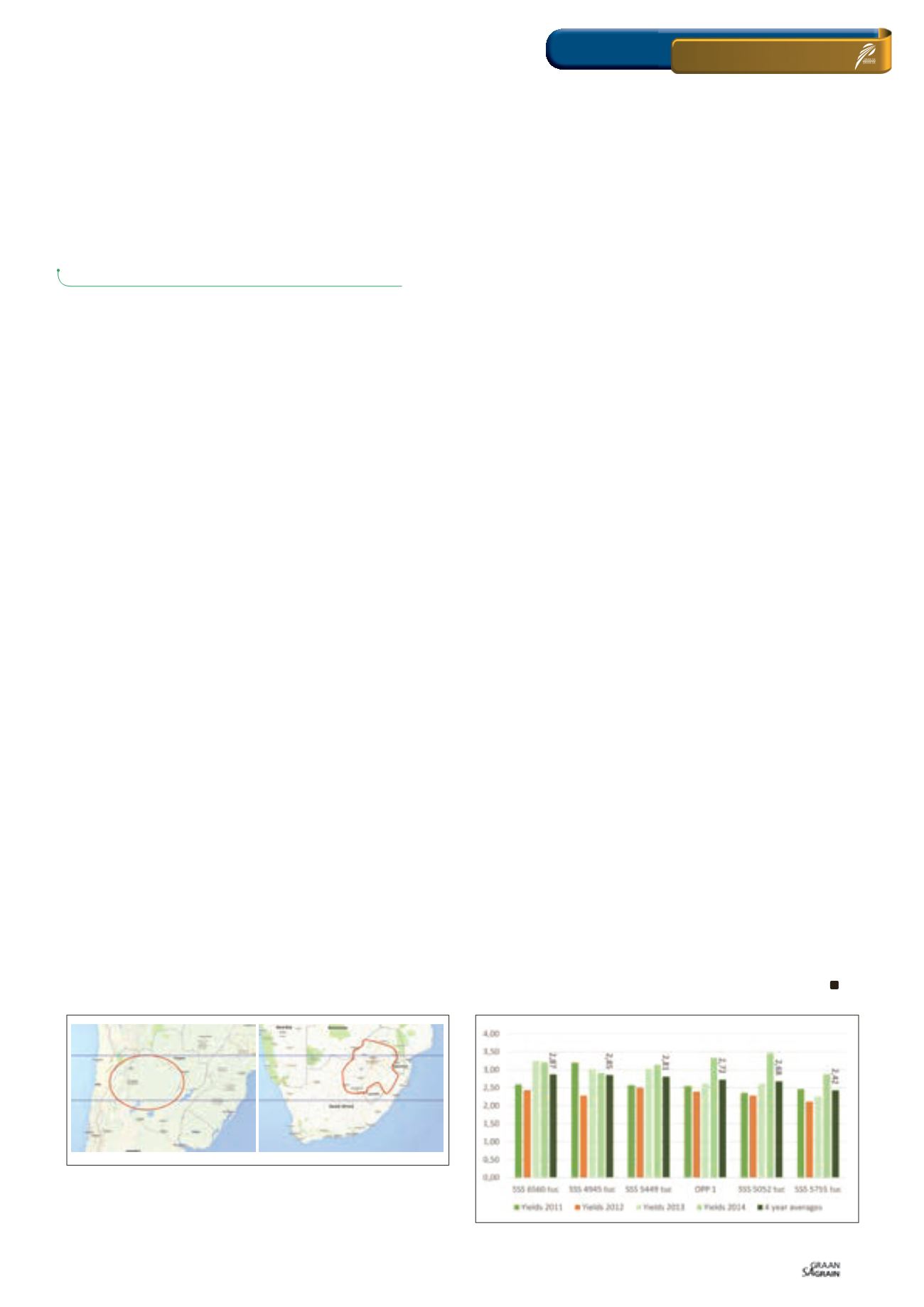

A look at Sensako’s soybeans and
the Argentinian connection
S
oybean varieties recently released for production by
Sensako in South Africa, originate from the soybean
breeding programme of the Estación Experimental Agroin-
dustrial Obispo Colombres (EEAOC).
This public institution is the oldest agricultural research station in
Argentina. It was founded in 1909 with the main objective of improv-
ing agricultural production in the province of Tucumán through re-
search and extension activities, and has played an important role
in the introduction and improvement of new crops in the region
and the development of crop management practices, soil conserva-
tion and disease management programmes.
The EEAOC played a pioneer and key role in the introduction
and development of soybean as a grain crop in the early 1960s,
introduced germplasm from different countries and evaluated
and recommended cultivars that became widely used in northern
Argentina. The EEAOC started their own breeding programme in
the late 1970s, released several conventional varieties in the follow-
ing years and in 2001 became the first public institution to release
glyphosate-resistant cultivars: Munasqa RR and Qaylla RR, which
became resounding success stories.
One of the new Sensako varieties – SSS 6560 (tuc) – is closely related
to Waynasoy (a sister and advanced line from Munasqa RR and near-
ly identical, recently released in Argentina). During initial soybean
trials, Munasqa (Maturity Group 8) and Yanasu (Maturity Group 7)
were planted in South Africa (2010/2011), but both cultivars showed
growing cycles too long for local conditions.
Recently, the EEAOC has released another three RR cultivars for
northern Argentina, three for Bolivia and one for Brazil. This infor-
mation shows the continuous and efficient work of a strong team,
which includes breeders, pathologists, entomologists, physiologists
and biotechnologists that for many years has been able to produce
quality materials that have excelled in different latitudes.
Sensako is in the fortunate position to cooperate with this excellent
research team and source the best germplasm for the best local
soybean cultivar development. During initial discussions on the suit-
ability of germplasm, a comparison was made between the origins
of the Argentinian material in the Tucumán province as related to
South African soybean production regions.
As indicated on the map (
Figure 1
), the soybean production areas
of South Africa and Argentina lies between the same latitudes and
it can be assumed that similar climatic conditions, in particular day-
light duration during the growing season, occurs. Rainfall, maximum
temperatures and relative humidity tends to be marginally higher
compared to the averages of the summer rainfall region in South
Africa (
Wikipedia
).
The range in altitude is also wider in Argentina (from lowlands to
high altitude grasslands) as in the summer rainfall region of South
Africa. Generally speaking, the Tucumán region is closely related to
local production regions, and germplasm and cultivars are better
adapted than cultivars sourced from warmer, higher latitudes.
Soybean cultivar development at Sensako
Cultivars sourced from the EEAOC have been extensively tested
in statistical trials planted on nine localities representing the major
South African soybean production areas over the past two years.
These trials provided extensive information under varying and di-
verse environmental conditions and allowed the evaluation of
yield potential, adaptability, stability and stress resistance of vari-
eties. The Argentinian breeders (EEAOC-Tucumán) visited the joint
soybean trial programme of Sensako in March. Statistical trials
in KwaZulu-Natal and the Eastern Highveld, and seed production
fields were evaluated.
The EEAOC material again proved to be well-adapted in South
Africa and shows outstanding performance. The best management
and agronomic practices (row widths, plant population and seed
treatments) specifically related to the Argentinian sourced cultivars
are currently also tested in trials. From the yield results in
Graph 1
it is evident that the new Sensako soybean cultivars are highly com-
petitive with locally available cultivars over the past four produc-
tion seasons, producing stable and high average yields.
Sensako released five soybean cultivars in joint collaboration with
the EEAOC for the 2015 production season, ranging in agronomical
characteristics, maturity group and adaptation to different environ-
ments. These cultivars are recommended for dryland as well as
irrigation production systems and are competitive with locally pre-
ferred cultivars for both grain and oil yield. Additional yield results
and information on these cultivars are available from Sensako.
81
August 2015
ON FARM LEVEL
Seed
ROEAN WESSELS
and
FRANCOIS KOEKEMOER,
Sensako
Graph 1: Yield results of soybean cultivars for 2011 - 2014.
Figure 1: A map of the respective soybean production regions of
South Africa (right) and Argentina (left) indicating that the soybean
production areas of South Africa and Argentina are situated between the
same latitudes and it can be assumed that similar climatic conditions, in
particular daylight duration during the growing season, occurs.
Product information

















